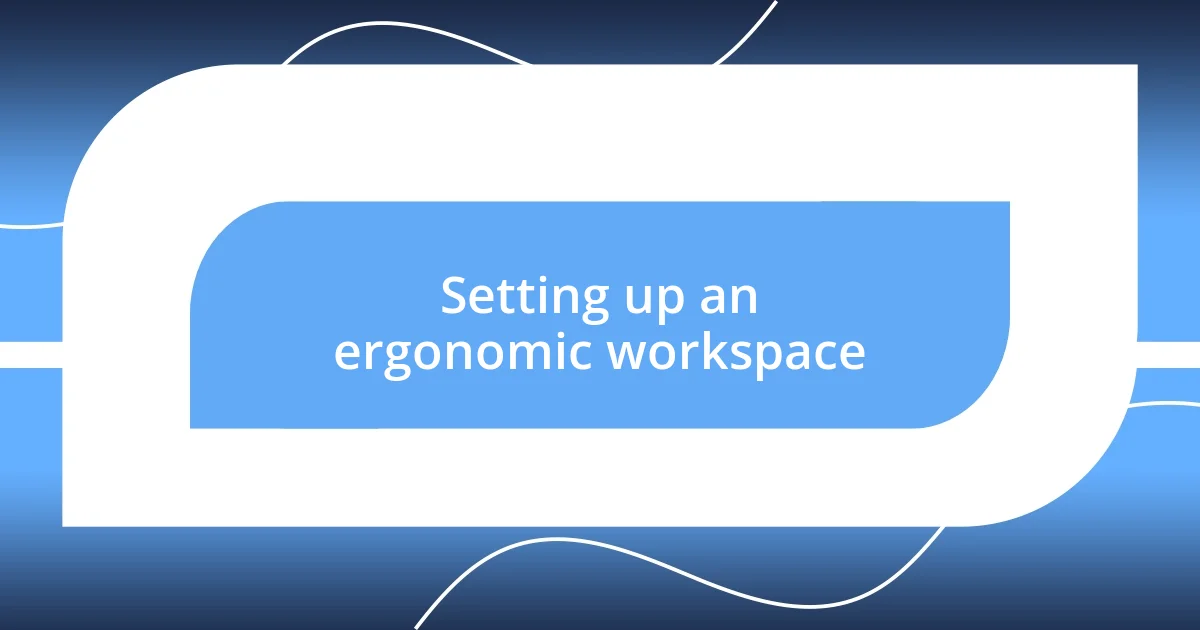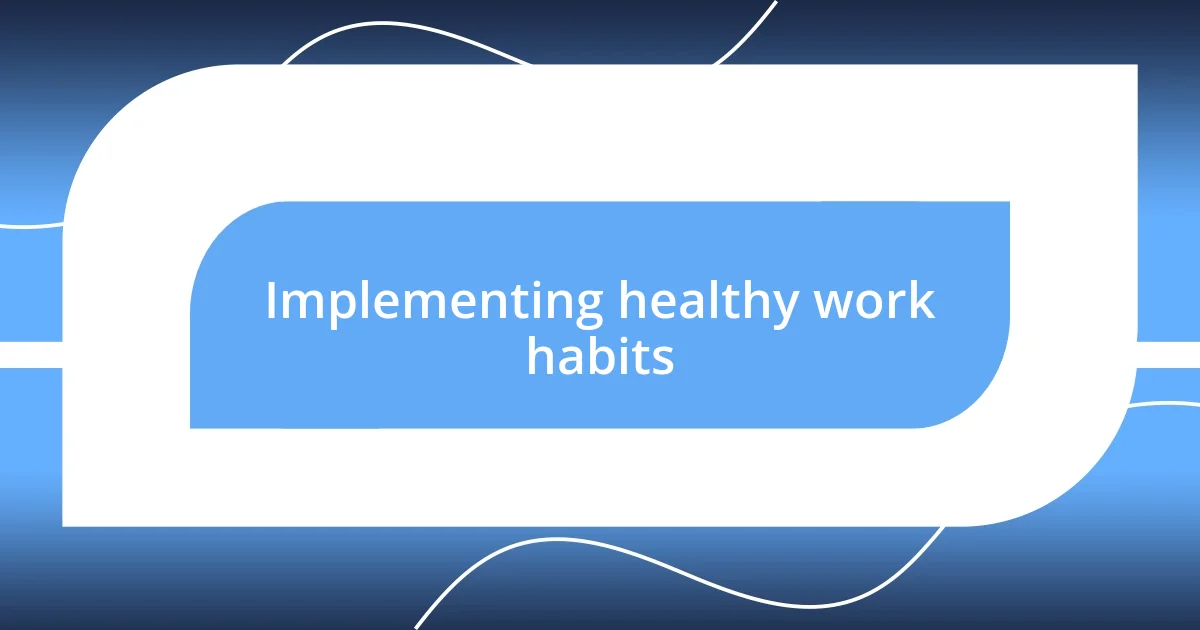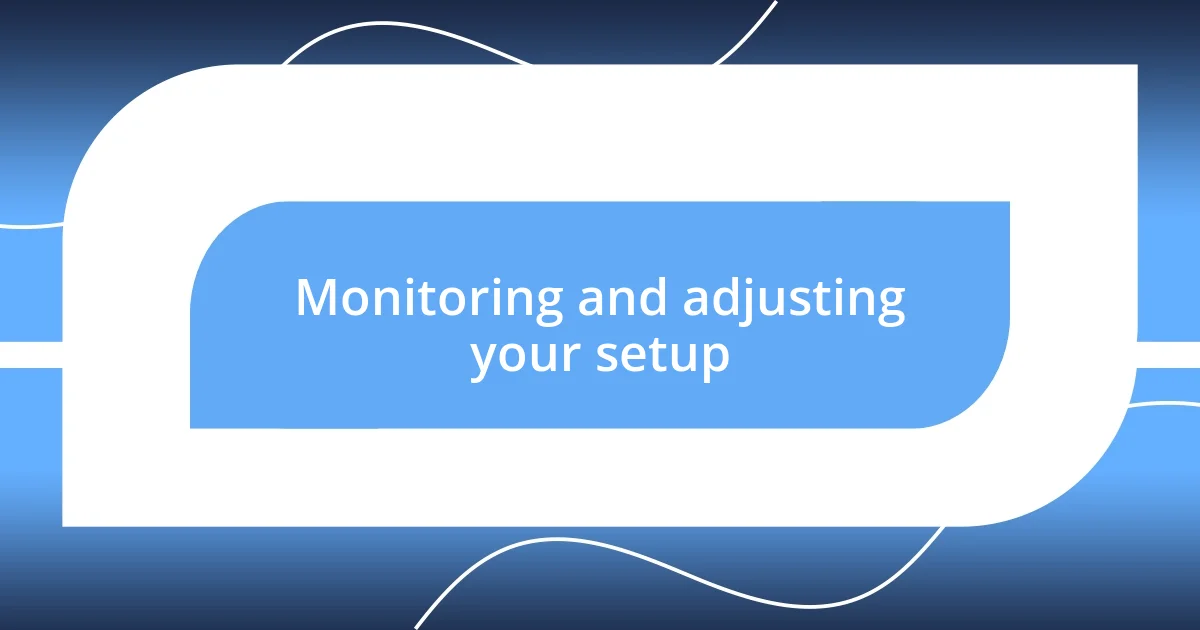Key takeaways:
- Implementing ergonomic solutions, such as adjusting chair height and monitor placement, significantly enhances comfort and productivity by promoting better posture and reducing strain.
- Regularly monitoring and adjusting the ergonomic setup is essential; awareness of body signals helps prevent discomfort and maintains efficiency over time.
- Incorporating healthy work habits, such as taking breaks and staying hydrated, complements ergonomic technology, leading to improved well-being and focus during work hours.

Understanding ergonomic technology
Ergonomic technology revolves around designing tools and environments that enhance comfort, efficiency, and well-being. It’s fascinating to see how a simple adjustment, like an ergonomic chair, can transform the way I feel during long work hours. I remember the relief I felt when I switched to a chair that truly supported my back; it was like lifting a weight off my shoulders.
When I first started exploring ergonomic tech, I often wondered why it mattered so much. Wasn’t a standard office setup good enough? However, after experiencing persistent neck pain from slouching over my desk, I quickly realized the importance of investing in ergonomic solutions. It’s incredible how technology aligns with human anatomy to promote better posture and productivity.
I’ve discovered that ergonomic devices are not just for office workers—they can benefit anyone. Whether it’s an adjustable standing desk or special mouse designed to reduce strain, the right ergonomic tools can significantly impact daily comfort. I find myself asking: How has a small change in my workspace made such a huge difference in my energy levels? Understanding ergonomic technology has truly empowered me to take control of my workspace and my well-being.

Identifying personal ergonomics needs
Identifying personal ergonomic needs is a journey of self-discovery. At first, I didn’t realize how my workspace was affecting my body until a friend pointed out my constant fidgeting and discomfort during meetings. It made me pay attention to the subtle cues my body was sending, and I began to explore what adjustments I could make to alleviate these issues.
To help pinpoint my specific ergonomic needs, I started to observe various aspects of my workspace and habits:
- Posture: I monitored how I sat and noticed the tension pooling in my shoulders and lower back.
- Height of desk and monitor: I assessed whether my screen was at eye level, which affected my neck’s alignment.
- Keyboard and mouse placement: I experimented with different positions to see which felt most natural for my wrists.
- Frequent breaks: I tracked how often I took breaks and whether a standing desk option would encourage movement.
- Personal comfort items: I considered whether accessories, like a footrest or lumbar support cushion, could provide additional relief.
This process of evaluation not only created a tailored ergonomic setup for me, but it also empowered me to be proactive about my comfort and well-being at work. Each small adjustments led to a noticeable difference in how I felt throughout the day.

Choosing the right ergonomic devices
Choosing the right ergonomic devices can feel overwhelming. I remember standing in an office supply store, staring at a wall of chairs and wondering which one would truly make a difference. Eventually, I learned that not all ergonomic devices are created equal; what works for someone else might not work for me. Personal comfort is key, and testing them out whenever possible can lead to remarkable revelations.
I found that adjustable features in devices can significantly enhance their effectiveness. For instance, when I switched to an adjustable keyboard tray, I noticed a drastic reduction in wrist strain. It was a small change, but having the ability to customize my workspace truly transformed my experience. Sometimes, I even recommend visiting showrooms to try these devices before committing to them.
In my journey, I also realized the importance of integrating ergonomic devices gradually. Instead of overhauling my entire workspace at once, I replaced items one by one. This approach not only eased my budget but also allowed me to assess the impact of each change. For example, after adding an ergonomic mouse, it took only a few days to notice less discomfort in my wrist. Taking the time to choose the right devices thoughtfully correlated with the improvements in my productivity and comfort.
| Device Type | Key Features |
|---|---|
| Ergonomic Chair | Adjustable height and lumbar support |
| Standing Desk | Height adjustable for sitting/standing |
| Ergonomic Mouse | Design to minimize wrist strain |
| Keyboard Tray | Adjustable angle and height |
| Footrest | Encourages better posture and circulation |

Setting up an ergonomic workspace
Once I started setting up my ergonomic workspace, I quickly discovered the significance of proper desk height. I vividly remember the day I realized my desk was too high, leading to discomfort in my arms. Lowering it made an instant difference—I felt the tension in my shoulders release. Isn’t it fascinating how such a simple adjustment can change your entire work experience?
Next, I focused on my monitor placement. I often found myself craning my neck to get a better view, and it became clear that aligning my monitor to eye level was essential. I decided to use a stack of books as a temporary solution while I waited for an adjustable monitor stand. It was an eye-opening experiment; I literally felt less strain as I corrected my posture. Do these small changes seem trivial? They certainly weren’t for me; they transformed the way I interacted with my work.
Finally, I explored the comfort and benefits of supportive accessories. A footrest might seem like a minor detail, but when I started using one, I noticed a significant upgrade in my overall comfort. It felt like having my feet firmly planted on the ground rather than dangling like before. Why don’t more people talk about these little tweaks that can promote well-being? For me, each element culminated into a cohesive space that truly reflected what I needed to work at my best.

Implementing healthy work habits
I’ve learned that implementing healthy work habits goes beyond just having the right ergonomic devices. For instance, I started to incorporate short breaks into my routine, and the benefits were immediate. During these five-minute pauses, I’d stretch or take a quick walk around the room. It’s amazing how a brief moment away from the screen can refresh my mind and body. Have you ever noticed a shift in your focus after taking a quick break? It can be a game-changer.
Another adjustment that worked wonders for me was adopting a consistent posture throughout the day. I focused on aligning my back with the chair and keeping my feet flat on the ground. Initially, it felt awkward, but over time, it became second nature. I often found myself setting reminders on my phone to check in on my posture; this little nudge made a huge difference. Have you ever thought about how much your posture influences your energy levels? I didn’t realize the extent until I made a conscious effort.
Additionally, I began to prioritize my hydration and nutrition while working. Having a water bottle within arm’s reach became a habit, and I noticed I felt more energetic and focused. I once experimented by tracking my water intake for a week, and the results were eye-opening. It’s surprising how proper hydration not only impacts physical well-being but also mental clarity. How often do you pause to drink water during your busy workday? Making this simple habit a priority transformed my overall productivity and well-being.

Monitoring and adjusting your setup
I realized that monitoring my ergonomic setup was a continuous journey rather than a one-time task. After a few weeks of working at my adjusted desk, I started to feel subtle aches creeping back. That’s when I understood the importance of regular check-ins; I began to set a weekly reminder to assess my setup. Have you ever noticed how easily you can fall back into old habits? That simple practice kept me aware and in tune with my body.
When I noticed the strain returning, I instinctively adjusted my chair height yet again. I didn’t want to ignore the signs my body was telling me. It was like a dance; I’d make a change, sit for a while, and see how my body responded. One particular afternoon, after adjusting my monitor slightly closer, I felt an immediate surge of relief. Isn’t it incredible how being attentive can lead to such immediate adjustments? Each shift made me more comfortable and more productive.
Incorporating a habit of observing my posture was another revelation. I started to ask myself, “How does my body feel right now?” I’d look in the mirror as I adjusted my seat, reminding myself of the alignment I wanted to maintain. Even a simple adjustment of rolling my shoulders back significantly enhanced my focus. Have you ever taken a moment to check in with your body? It’s amazing how something so simple can dramatically improve your comfort and efficiency during those long work hours.

Evaluating long-term benefits of ergonomics
Evaluating the long-term benefits of ergonomics has been eye-opening for me. Initially, I was skeptical about how meaningful these adjustments could be, but I’ve come to appreciate a noticeable reduction in discomfort over the months. It’s like my body is thanking me! Have you ever had that moment when you realize your regular aches and pains are disappearing? That relief can empower your entire day.
I remember a day when I sat back to assess how ergonomics changed my productivity levels. With the right chair, desk height, and monitor positioning, I felt my focus sharpen dramatically. It was almost revelatory when I could complete tasks without the nagging distraction of discomfort. How many times do we allow minor irritations to derail our efficiency? I learned that addressing these small concerns reaps significant, long-term benefits.
Reflecting on my journey, I can confidently say that embracing ergonomic adjustments has improved not only my physical health but also my overall mindset. It’s like this constant sense of well-being envelops me, enabling a more positive outlook on my work. Have you ever considered how much physical comfort influences your mental state? For me, it’s quite profound; when I feel good physically, I’m ready to take on challenges with enthusiasm.













